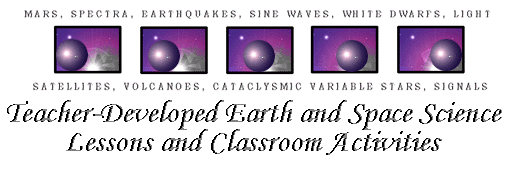
This site has been rated by
the
by
the 

Topics covered by these lessons:
Doing Astrophysics Research with an Artificial Earth Orbiting
Satellite, Sine Waves, The Electromagnetic Spectrum, Images of the Universe
in Different Wavelengths, Satellite Communications, Satellite Dishes, Constellations
and the Zodiac, Solar System Objects, Earthquakes, and More!
 When
creating your own lesson, you may want to look at the following Lesson
Plan Template.
When
creating your own lesson, you may want to look at the following Lesson
Plan Template.
- The
Martian Sun-Times by Florence Vaughan and Jeff Benson. Intended
for junior high school students and their teachers. Student weather
reporters investigate seasons, temperatures and clouds on Mars
and compare them to Earth.
- Electromagnetic
Radiation - On Trial by Nellie Levine (aka N. Levandovsky.) Intended for high school
students and their teachers. This lesson engages students in collaborative
work to gather evidence regarding beneficial or nefarious properties of
various types of electromagnetic radiation.
Students place the electromagnetic spectrum "On Trial" and take
advantage of an electronic interactive WWW forum to gather, post, and discuss
their evidence.
- The Extreme Ultraviolet
Explorer (EUVE) Satellite Orbit by Leslie Dietiker, Delano Spicer and
Isabel Hawkins. Intended for 9th or 10th graders and their teachers,
in introductory math classes or trigonometry. Students will use this
lesson plan to obtain data directly from the EUVE
satellite , in the form of the position of the EUVE above the Earth
as a function of time. Students will then be able to graph the position
of the EUVE satellite on a map of the world and investigate periodic functions
such as sine and cosine. The EUVE satellite offers a wonderful opportunity
for students to see a real application of math to space science, to ask
questions about how satellites stay in orbit and to see how mathematics
provides a tool for analyzing information about space astrophysics satellite
missions.
- Extreme Ultraviolet
Explorer (EUVE) Satellite Data Flow Demonstration by Marlene Wilson
and Dennis Biroscak. Intended for use by 4th-12th grade students who
have ball-throwing and ball-catching skills. This is a hands-on demonstration
of the communication path between the EUVE
satellite and a scientist on Earth.
- The Extreme Ultraviolet
Explorer (EUVE) Satellite Guest Investigator Puzzle by Timothy Keys
and Isabel Hawkins. Intended for use by 6th-8th grade students and their
teachers. The purpose of this lesson plan is to familiarize students
with astronomy and with the process of scientific research carried out
by professional astronomers using up-to-date data resources available on
the World Wide Web. Students will be able to participate in an astrophysics
lab accessing data from NASA's Extreme Ultraviolet Explorer (EUVE) satellite.
Students become familiar with a fundamental technique of astrophysics research
by matching EUVE spectra of "mystery" stars
with those of known stars.
- The
Great Satellite Search! by Regan Lum. Intended for 9th-12th graders.
This lesson is designed to teach students how to do Internet
research and then organize and present information.
- How Satellites See
by Chris Wilder. Intended for use by elementary school students and
their teachers. This project compares and contrasts three NASA satellites:
The Extreme Ultraviolet Explorer (EUVE), The Cosmic
Background Explorer (COBE), and the Hubble Space Telescope (HST) .
Students can compare physical parts and orbits of each satellite, will
compare images about how each satellite "sees" the Universe.
Students can also participate in hands-on experiments to begin to understand
visible, infrared, and ultraviolet wavelengths.
- Auroras:
Paintings in the Sky by Mish Denlinger. Intended for 6th-12th graders
An introduction to auroras and the processes
that create these mysterious lights.
- Graphing
Stratospheric Ozone by Neil Fedder. Intended for 11th and 12th graders
Students will learn how to plot raw data by plotting NASA
ozone surveys in Antartica.
- Take a Spin Through
the Solar System Original concept and authoring by Kevin McCarron and
Ginger Privat with additional authoring by Nellie Levine (aka N. Levandovsky.) Intended
for middle and high school students and their teachers. Have you noticed
how many things around you rotate? In this unit we are going to measure
and investigate rotation rates of different planets,
and even the Sun. We will base our research on the images and textual information
found on the Internet.
- Surfing for Earthquakes
and Volcanoes by Patty Coe and Michael Merrick. Intended for 6-8
graders Students use the Internet to research data on earthquakes
and volcanoes and plot locations to determine continental plate
boundaries. Extensions include interpretation of interaction between plate
boundaries, causes of earthquakes and volcanoes, and the comparison of
the formation of Olympus Mons on Mars and the Hawaiian volcanic chain.
- Third
from the Sun by Ronna Voorsanger. Intended for grades 4-8. Students
learn about earth imaging by Landsat satellites
and study images of earth to try determine their origins.
- Eyes in the Sky
by Bryan Yager. Intended for 6-8 graders.This lesson plan shows
how middle school students who are taking industrial technology classes
use technology to learn about orbiting spacecraft
designed to study astronomical objects.
- What is Your Sign?
The Science Behind the Zodiac by Beth Napier Intended for secondary
students and their teachers. This lesson will help students describe
the meaning of the plane of the ecliptic,
and recognize and identify the constellations
of the Zodiac.
- Communication- Vibration,
Electronic Signals, and Electromagnetic Radiation: by Regan Lum. Intended
for use by high school students and their teachers. The main methods
of communication are speaking and listening.
One of the limitations of communication through speech is that the listener
must be within shouting distance. Through the miracle of science, we can
speak to a friend that is far away by sending our voice through the air,
wire, or glass fiber in the form of electromagnetic radiation or electronic
signals. We can even speak to machines such as space satellites orbiting
the Earth, or probes on their way to the outer planets of the Solar System
- and tell them what to do! These concepts are illustrated through exciting
hands-on demonstrations.
- Big
Trouble in Earthquake Country
- Geography
From Space
- Looking
At Earth Online Gallery
- Ski
Earth
Mail comments to outreach@cea.berkeley.edu
 1995,
1996 The Regents of the University of California.
1995,
1996 The Regents of the University of California.




 When
creating your own lesson, you may want to look at the following Lesson
Plan Template.
When
creating your own lesson, you may want to look at the following Lesson
Plan Template.